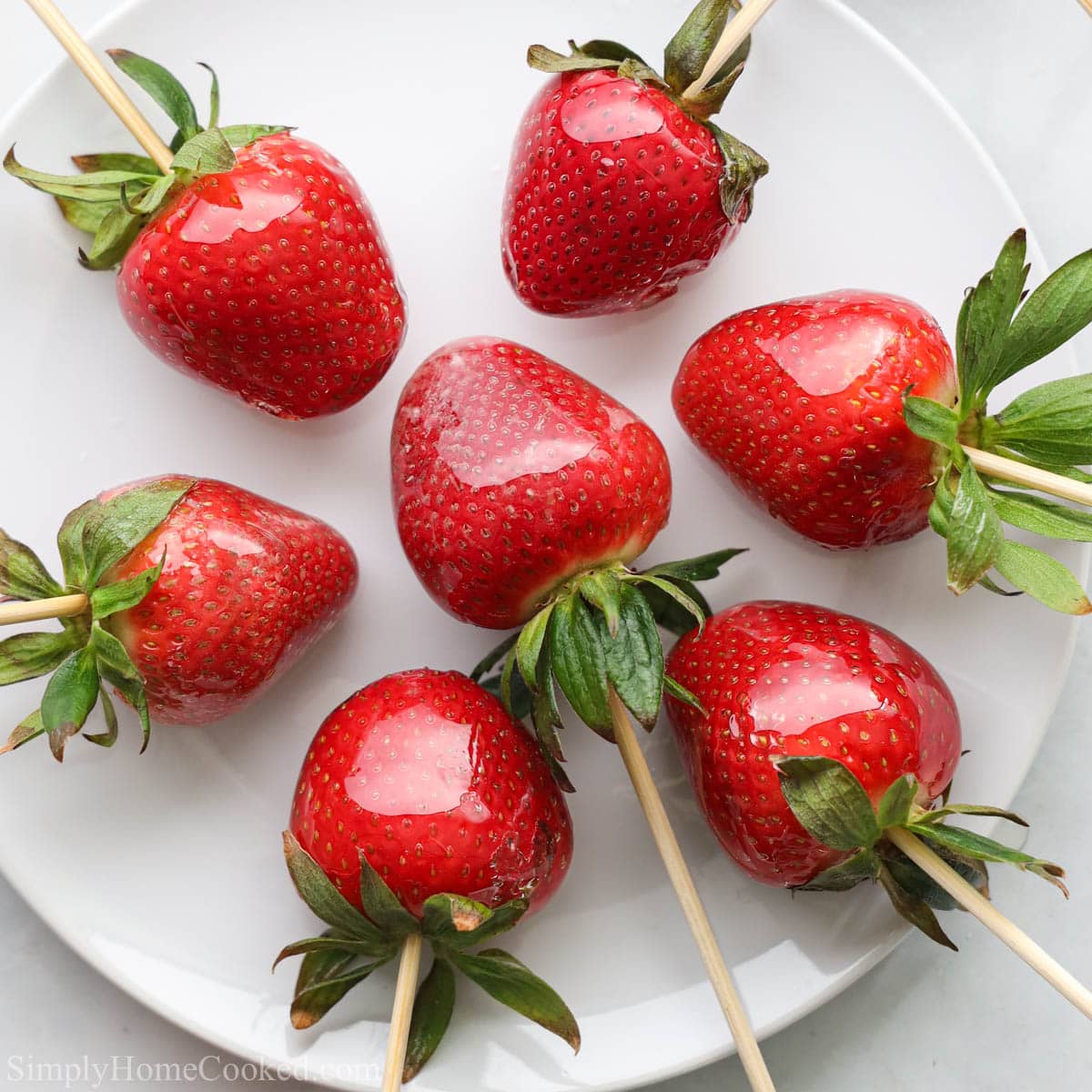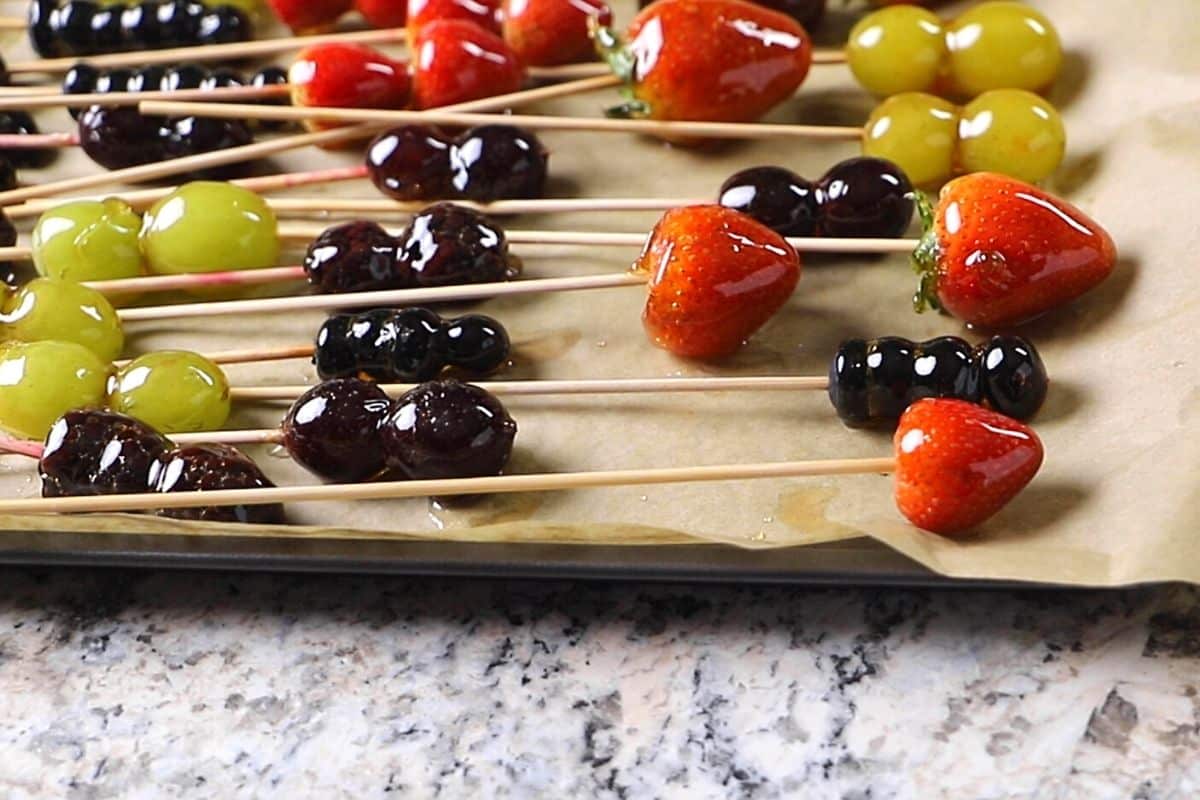Introduction to Tanghulu

Tanghulu, also known as Bingtanghulu, is a traditional Chinese snack that has been enjoyed for centuries. It consists of candied fruits, typically hawthorn berries, coated in a hardened sugar glaze. This sweet treat is not only delicious but also holds a special place in Chinese culture, representing both a beloved snack and a symbol of festive occasions.
History of Tanghulu
The origins of Tanghulu can be traced back to the Song Dynasty (960-1279 AD). During this period, sugar became more readily available, and people began experimenting with different ways to use it. It is believed that Tanghulu was initially created by dipping fruits in a simple sugar syrup, which then hardened into a glaze.
Traditional Ingredients and Preparation
The traditional ingredients for Tanghulu are simple and readily available. They include:
- Hawthorn berries:These are the most common fruit used for Tanghulu. They have a tart flavor that complements the sweetness of the sugar glaze.
- Sugar:White granulated sugar is typically used. It is dissolved in water to create a syrup that is then heated to a high temperature to form a hardened glaze.
- Water:Water is used to dissolve the sugar and create the syrup.
The preparation process for Tanghulu is relatively straightforward:
- Wash and prepare the fruits:The hawthorn berries are washed thoroughly and any stems or leaves are removed.
- Make the sugar glaze:The sugar is dissolved in water and heated over medium heat. The syrup is continuously stirred until it reaches a thick, syrupy consistency. This can be tested by dipping a wooden spoon into the syrup. If the syrup coats the spoon and forms a thin thread, it is ready to be used.
- Dip the fruits in the glaze:The prepared fruits are carefully dipped in the hot sugar glaze, ensuring they are fully coated.
- Let the glaze harden:The glazed fruits are placed on a wire rack or baking sheet to allow the glaze to harden. This can take several hours, depending on the thickness of the glaze.
- Serve:Once the glaze has hardened, the Tanghulu is ready to be served. It can be enjoyed fresh or stored in an airtight container for later consumption.
Cultural Significance of Tanghulu
Tanghulu holds a significant place in Chinese culture, particularly during festivals and celebrations. It is often associated with the Lantern Festival, which takes place on the 15th day of the first lunar month. During this festival, Tanghulu vendors set up stalls in the streets, selling their brightly colored treats to eager customers.
“Tanghulu is more than just a snack; it is a symbol of joy, celebration, and the sweetness of life.”
Tanghulu is also popular during other festivals, such as the Mid-Autumn Festival and the Spring Festival. It is often given as a gift to family and friends as a token of good luck and prosperity.
Nick Digiovanni’s Tanghulu Recipe
Nick Digiovanni, a renowned chef and food enthusiast, offers a unique take on the traditional Chinese dessert, Tanghulu. His recipe combines classic elements with innovative techniques, resulting in a truly delicious and visually stunning treat.
Ingredients
The key ingredients in Nick Digiovanni’s Tanghulu recipe are:
- Fresh fruit, such as strawberries, grapes, or apples, cut into bite-sized pieces
- Sugar
- Water
- Honey
- White vinegar
- Sesame seeds (optional)
Preparation Steps
Nick Digiovanni’s Tanghulu recipe involves the following steps:
- Prepare the fruit by washing and drying it thoroughly. Cut the fruit into bite-sized pieces, ensuring they are uniform in size.
- In a saucepan, combine sugar, water, honey, and white vinegar. Bring the mixture to a boil over medium heat, stirring constantly until the sugar dissolves completely.
- Reduce the heat to low and continue to simmer the syrup for about 5-7 minutes, or until it reaches a thick, syrupy consistency. This process is known as “caramelization,” where the sugar molecules break down and create a rich, golden-brown color.
- Carefully dip each piece of fruit into the hot syrup, ensuring it is fully coated. Use tongs or a skewer to lift the fruit from the syrup and allow any excess to drip off.
- Place the coated fruit on a baking sheet lined with parchment paper to cool and set. Once the syrup has hardened, the Tanghulu is ready to be enjoyed.
- Optionally, sprinkle sesame seeds over the cooled Tanghulu for added flavor and texture.
Unique Techniques
Nick Digiovanni’s Tanghulu recipe incorporates a few unique techniques that elevate the flavor and presentation of the dessert.
- He uses a combination of honey and white vinegar in the syrup, which adds a touch of sweetness and tanginess. The honey provides a rich, floral aroma, while the vinegar helps balance the sweetness and prevents the syrup from crystallizing.
- Nick Digiovanni also emphasizes the importance of using fresh, high-quality fruit. He believes that the quality of the fruit directly impacts the overall flavor and texture of the Tanghulu.
Variations and Adaptations

The beauty of tanghulu lies in its adaptability. While the classic recipe features candied hawthorn berries, countless variations exist, allowing you to personalize your treats. From experimenting with different fruits to exploring unique coatings, the possibilities are endless. This section will delve into common variations, guide you on adapting Nick Digiovanni’s recipe, and compare and contrast different tanghulu recipes.
Common Variations of Tanghulu
The traditional tanghulu uses hawthorn berries, but countless other fruits can be used.
- Other Berries:Strawberries, blueberries, raspberries, and even grapes can be used as alternatives. The smaller size of these berries makes them ideal for the classic tanghulu shape.
- Citrus Fruits:Mandarin oranges, kumquats, and even grapefruit segments can be candied. Their vibrant colors and juicy textures add a delightful twist.
- Other Fruits:Apples, pears, and even pineapples can be used for tanghulu, though they may require slightly different cooking times due to their size and density.
Beyond the fruit, the coating also offers room for creativity.
- Traditional Coating:The classic tanghulu coating is a simple sugar syrup, often flavored with rock candy or other sweeteners.
- Chocolate Coating:A decadent variation involves dipping the candied fruit in melted chocolate. This creates a rich and satisfying treat.
- Other Coatings:Experiment with other coatings like caramel, white chocolate, or even sprinkles for a fun and colorful presentation.
Adapting Nick Digiovanni’s Recipe
Nick Digiovanni’s recipe serves as a great foundation for creating personalized tanghulu variations.
- Fruit Selection:Swap the hawthorn berries for your preferred fruit, adjusting the cooking time accordingly. Smaller fruits will require less time, while larger fruits may need longer.
- Sugar Syrup:Adjust the sugar syrup’s consistency based on your preference. A thicker syrup will create a harder candy shell, while a thinner syrup will result in a softer texture.
- Flavorings:Experiment with different flavorings for the sugar syrup. Common options include vanilla extract, lemon zest, or even spices like cinnamon or star anise.
- Coating Variations:Once the candied fruit is cooled, explore different coatings. Chocolate, caramel, or even sprinkles can be added for a unique touch.
Comparing Different Tanghulu Recipes
Various tanghulu recipes exist, each with its own unique approach and flavor profile.
- Sugar Syrup:Some recipes call for a simple sugar syrup, while others incorporate rock candy or other sweeteners. The amount of sugar and water used can also vary, affecting the consistency and sweetness of the candy shell.
- Cooking Method:Some recipes involve simmering the fruit in sugar syrup, while others use a deep-frying technique. The cooking method can impact the texture and flavor of the tanghulu.
- Flavorings:The use of flavorings varies widely. Some recipes rely on traditional flavors like rock candy, while others incorporate more contemporary flavors like vanilla extract or citrus zest.
Tips and Tricks
Making tanghulu is a fun and rewarding experience, but achieving that perfect balance of crispy, sweet, and visually appealing results requires a few key tips and tricks. Here are some pointers to help you create tanghulu that will impress your taste buds and your guests.
Choosing the Right Fruit
The quality of your fruit directly impacts the final product. Opt for firm, ripe fruits that are free from blemishes and bruises. Avoid fruits that are too soft or overly ripe, as they may not hold their shape during the cooking process.
- Apples:Choose varieties like Granny Smith, Honeycrisp, or Fuji for their firm texture and tart flavor.
- Strawberries:Select large, ripe strawberries with a deep red color.
- Kiwis:Opt for firm, green kiwis with smooth skin.
- Peaches:Choose ripe peaches with a slightly firm texture.
Preparing the Fruit
Thoroughly wash and dry the fruits before skewering. For apples, you can remove the core and cut them into wedges or leave them whole, depending on your preference.
Preparing the Sugar Syrup
The key to a successful tanghulu lies in the sugar syrup. Here are some tips for achieving the perfect consistency:
- Use high-quality sugar:Granulated sugar is the best choice for tanghulu. Avoid using brown sugar or other types of sugar as they may not crystallize properly.
- Control the heat:The sugar syrup needs to reach a specific temperature to achieve the desired consistency. Use a candy thermometer to monitor the temperature.
- Avoid overcooking:Overcooked sugar syrup can become too hard and brittle.
Skewering the Fruit
Use sturdy skewers that can withstand the heat of the sugar syrup. Skewer the fruits evenly and securely, ensuring they are not too close together.
Dipping and Cooling
Dip the fruit skewers into the hot sugar syrup, coating them evenly. Avoid overcrowding the pot during dipping. Once dipped, immediately transfer the skewers to a parchment-lined baking sheet to cool. Allow the sugar syrup to cool and harden completely before serving.
Preventing Sugar Crystallization
Sugar syrup can crystallize if it cools too quickly. To prevent this, keep the syrup warm during dipping and allow it to cool slowly.
Troubleshooting Common Issues
- Sugar syrup not crystallizing:If the sugar syrup is not crystallizing, it may be due to insufficient cooking time or too much water.
- Sugar syrup too hard:If the sugar syrup is too hard, it may be due to overcooking.
- Fruits not coated evenly:Ensure the fruit is fully submerged in the sugar syrup during dipping.
Conclusion

Whether you’re a seasoned chef or a curious beginner, Nick Digiovanni’s tanghulu recipe is a gateway to a world of culinary creativity. Experiment with different fruits, coatings, and garnishes to personalize your own unique tanghulu creations. Remember, the beauty of this treat lies in its versatility, allowing you to unleash your inner artist and create a delicious masterpiece that reflects your individual taste.
So, gather your ingredients, put on your chef’s hat, and get ready to experience the magic of tanghulu – a sweet and savory adventure waiting to be savored!